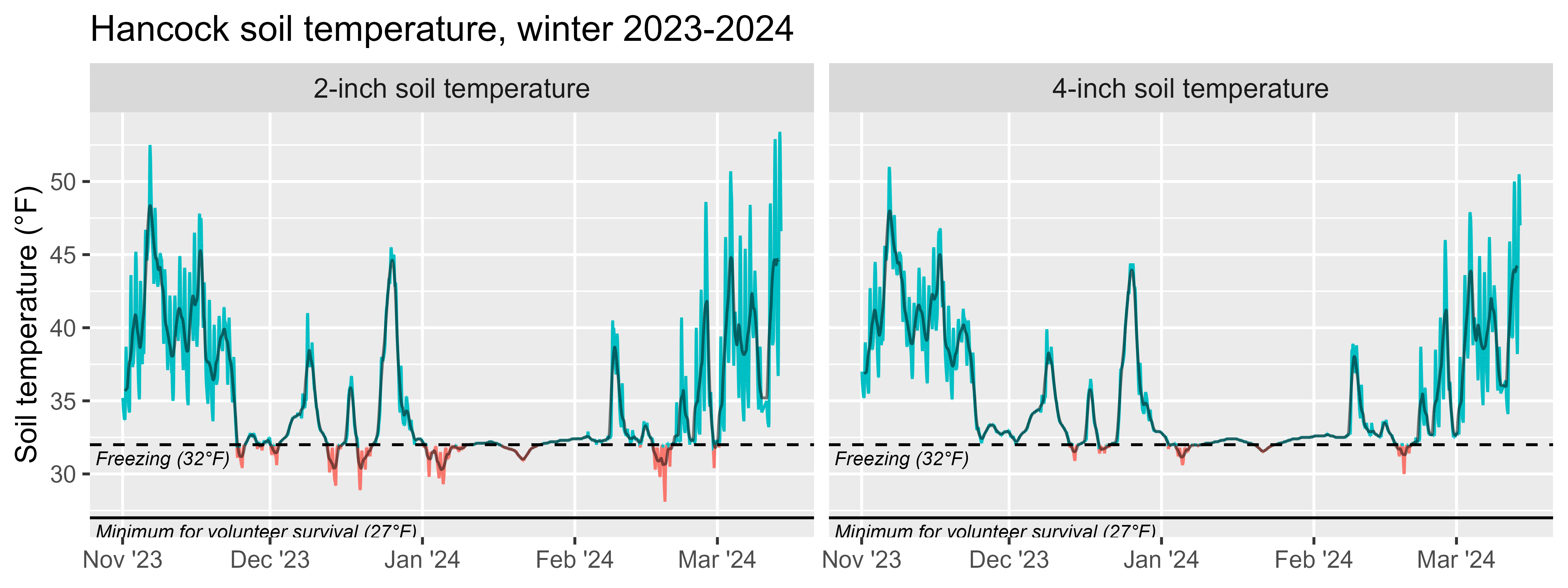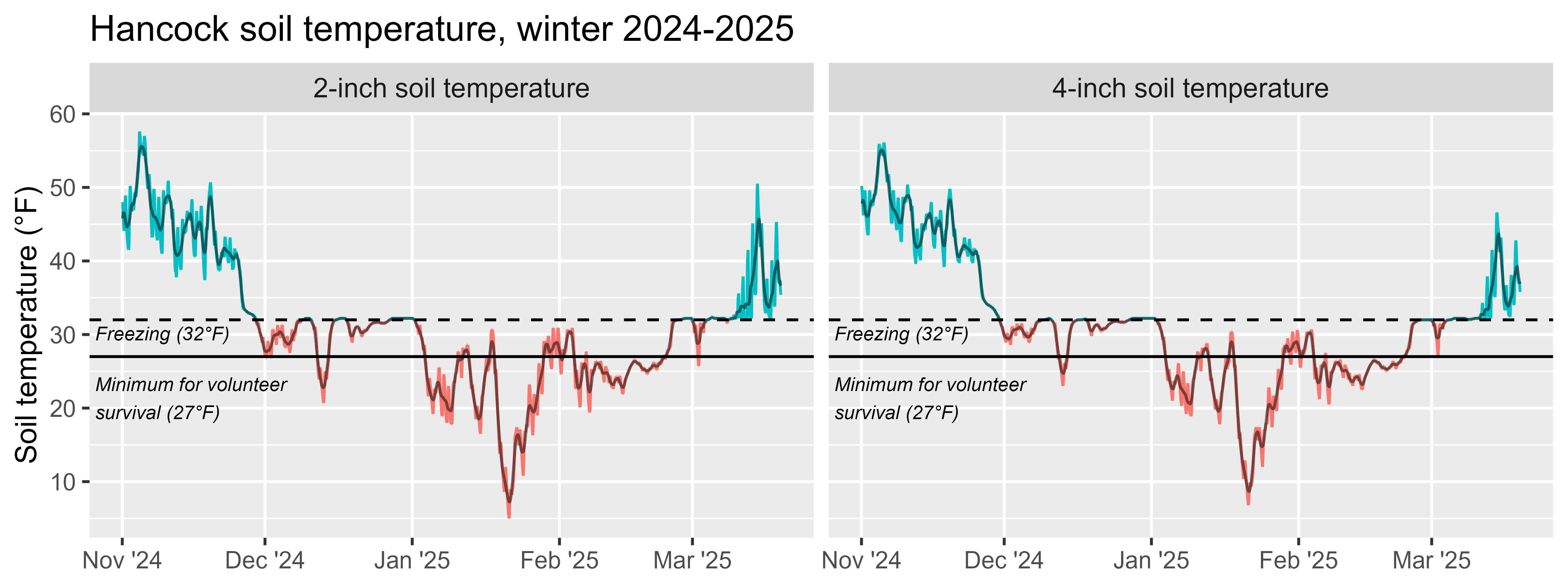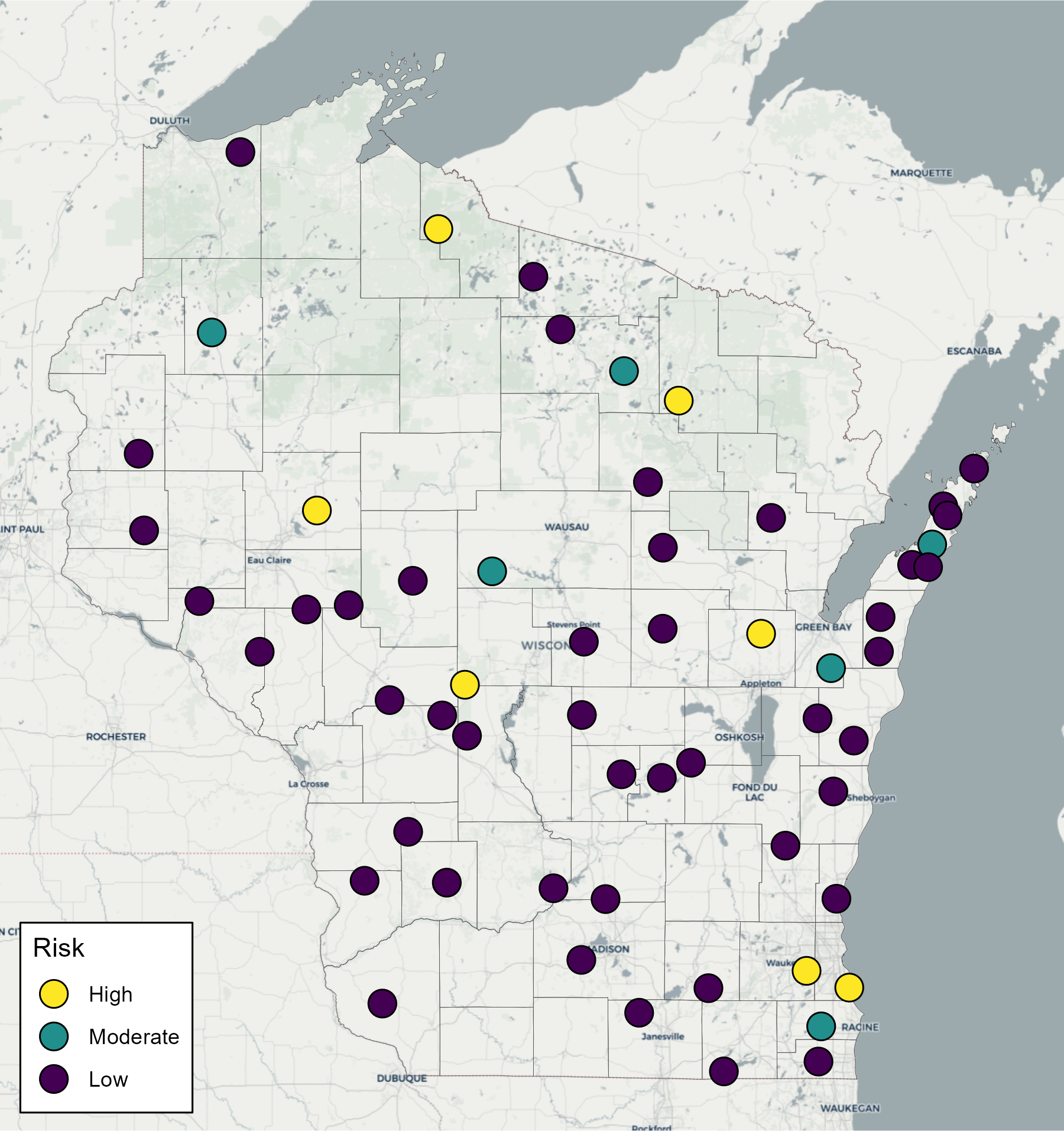This winter of 2024-2025 was markedly different than the last in terms of air and soil temperature and risk of potato volunteer survival. As per the University of Wisconsin Climatology Office, the winter saw minimal snowpack and sustained subfreezing conditions through early to mid-February, and frost extended deep into the ground until the mid-February snowstorms added insulation. These conditions further slowed frost progression despite subzero temperatures in some areas. By February 20, the statewide frost depths ranged from 10 to 35 inches which is considered normal to below normal (read more: go.wisc.edu/4d4i9x).
Based on 2008 work conducted by Dr. Willie Kirk (Michigan State University) and Dr. Phil Wharton (now at University of Idaho), 4-inch soil depth temperatures below 27°F for 120 hours are sufficient to kill off any volunteer potatoes remaining in the field (learn more: go.wisc.edu/3so332). Volunteer survival can result in sprouts which may be challenging to manage, and may serve as a potential source of pathogen inoculum in the spring.
The table below illustrates the model used to determine the likelihood of volunteer survival over winter base on soil temperatures between November 1 and March 31.
| Hours below 27°F at: | ||
| 2-inch depth | 4-inch depth | Risk |
| 120+ | 120+ | Low |
| 120+ | 0-120 | Moderate |
| 0-120 | 0-120 | High |
Based on soil temperature data retrieved from the University of Wisconsin Hancock Agriculture Research Station (HARS) weather station (wisconet.wisc.edu/stations/hancock), these low temperatures were reached this winter for durations greater than 120 hours, so the risk of potato volunteers is low in the coming 2025 growing season. Volunteer potatoes can introduce an increased risk of serious diseases such as late blight since they typically appear in fields and margins that are not being managed for potato in the current growing season so do not receive preventive fungicide applications (More information: vegpath.plantpath.wisc.edu/diseases/potato-late-blight).


Above, we share the soil temperature records from the HARS weather station, winter 2024-2025 and 2023-2024, for comparison. Note the differences in sub-freezing soil temperatures and durations of sub-freezing soil temperatures between the years. In 2024-25, the soil froze to below 27°F for Dec-Mar indicating a low risk for potato volunteer survival.

A look around the state of Wisconsin reveals that there are 7 weather station locations with high risk of volunteer survival and 5 locations with moderate risk. The figure below shows the Wisconet weather station locations (circles) with the color of circle indicating potato volunteer survival risk. The deep purple circles indicate low risk, teal is moderate risk, and yellow is high risk. These stations are located in grassy and generally open areas outside of agricultural fields and away from tree lines. Explore the data yourself in the online dashboard: connect.doit.wisc.edu/potato-volunteer-risk.
Cooler winters can create conditions less than favorable for the survival and activity of soilborne and debris-borne potato pathogens which challenge growers in Wisconsin and other regions. It’s important to note, however, that factors other than temperature alone, like soil moisture and crop residue, can also influence the viability of pathogens. The pathogens that persist in our growing region are hearty and adapted well to overcome inhospitable environmental conditions.
Fundamentally, most soil microbes require temperatures between 50-96℉ to sustain life. Soil microbial activities decrease with low soil temperatures and at freezing (32℉), most activities stop, likely killing the microbe if not protected or insulated in some way. The magnitude and duration of the cold, as well as soil moisture content and the presence of protective structures are critical pieces of information in considering the disease risk.
Pathogens of concern in potato which reside in agricultural fields (in and outside of plant debris) over the winter months include fungi Alternaria solani causing early blight, Alternaria alternata causing brown spot, Colletotrichum coccodes causing black dot, Fusarium spp. causing wilt and dry rot, Helminthosporium solani causing silver scurf on tubers, Rhizoctonia solani causing black scurf and Rhizoctonia stem canker, Sclerotinia sclerotiorum causing white mold, Verticillium dahliae causal agent along with nematode Pratylenchus penetrans in potato early dying; oomycetes or water molds Phytophthora infestans causing late blight, Phytophthora erythroseptica causing pink rot, Pythium ultimum causing Pythium leak; bacteria Streptomyces scabies causing common scab, and Pectobacterium and Dickeya spp. causing blackleg and tuber rot; and plasmodiophorid Spongospora subterranean causing powdery scab. While this list is not comprehensive and omits pathogens vectored by insects, it’s still imposing to consider the potential pathogen challenges in the production field.
Integrated management is essential in addressing the pathogens that you anticipate based on knowledge of field history and seed quality. Key elements of a best disease management program include host resistance, clean seed, cultivation especially leading to enhanced biodegradation of plant residues harboring pathogens, planting timing, crop rotation, irrigation management, fertility, weed management inputs, insect management inputs, and pathogen management including chemical, biological, and biopesticidal inputs. Note the holistic listing of just about every crop production input! A stressed plant is a plant with greater susceptibility to infection.
Late blight. We have been successful in keeping late blight out of potato production in Wisconsin and the northern United States in recent years. This outcome reflects the tight control of seed potato crop health and disease management in production fields. Late blight is initiated from mycelium of the pathogen which survives between growing seasons by overwintering in infected potato tubers intended for seed, or as volunteer tubers that are left in fields at harvest, or within discarded cull and rock piles. Recall that the late blight pathogen that we have in North America is by-and-large asexual and does not produce soil persistent long-term oospores.
As a reminder to Wisconsin growers, as per the Wisconsin Administrative Code ATCP 21.15 Potato Late Blight, cull potato piles must be destroyed by May 20 of each year to prevent late blight spore production and disease initiation in the state. Destruction can be achieved by land spreading the culls with incorporation, feeding culls to livestock, landfill, or other approach which requires DATCP written approval. For more details, visit go.wisc.edu/yk7114.
Wisconet, Wisconsin’s Environmental Mesonet (wisconet.wisc.edu), is a growing network of weather and soil monitoring stations across Wisconsin that provides high-quality data at high spatial and temporal resolutions. There are currently 58 weather stations with plans to expand to 80 by 2026. Each station provides more than one dozen measurements every 5 minutes.
For more information about our potato and vegetable disease modeling support, please visit our UW Vegetable Pathology website at vegpath.plantpath.wisc.edu/.